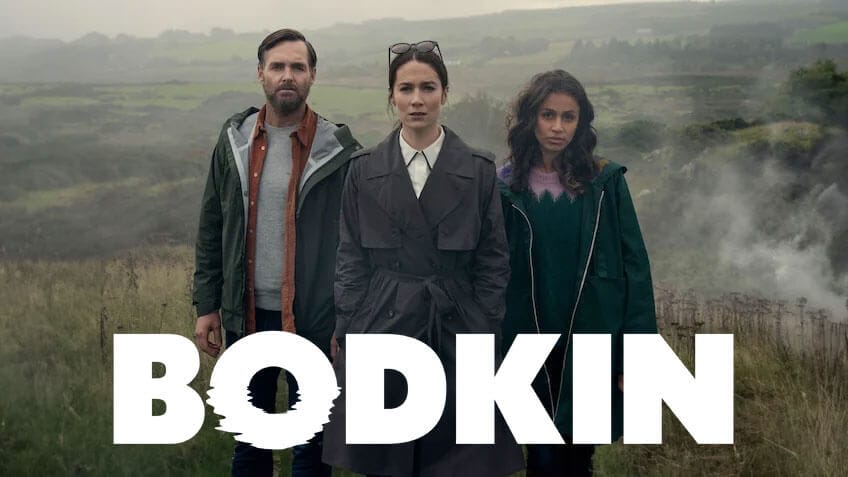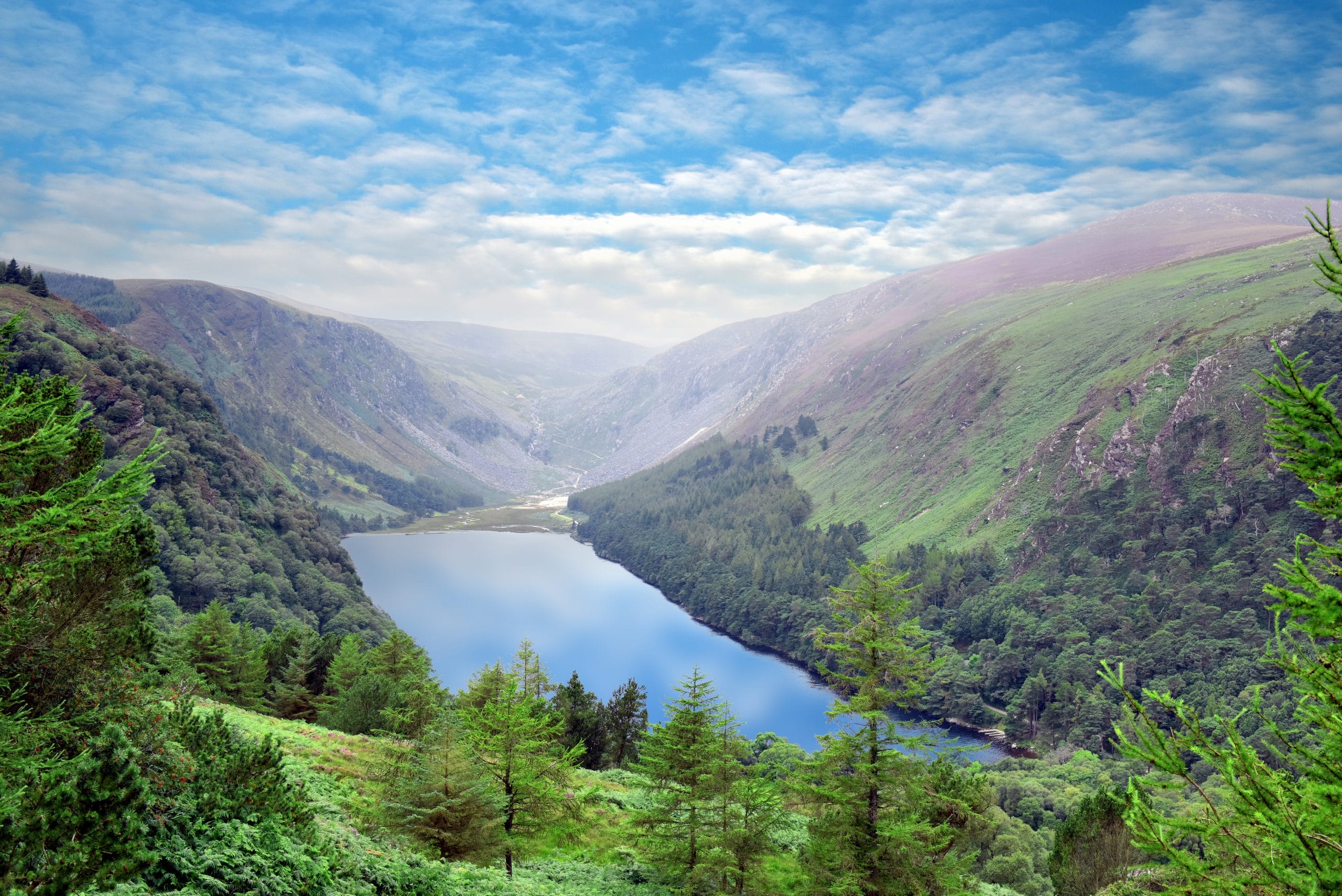
Route Overview
Where is the Wicklow Mountains?
The Wicklow Mountains is an area of continuous rolling hills and majestic mountains in Ireland. The 70km (or 43.5 miles) long-distance trail is located in County Wicklow, just South of Ireland’s capital, Dublin. This area is Ireland’s largest extensive mountain range with more than 500km2 above 300 metres. The land stretches from the north of Dublin, to the border with the counties of Wicklow and Carlow in the south.
Why should you walk the Wicklow Mountains?
The Wicklow Mountains were created 400 million years ago but they owe their current shape largely to the effects of the last ice age, when glaciers deepened the valleys and created many large lakes throughout the area. These days, the Wicklow Mountains are considered a major destination for tourism and recreation in Ireland.
Despite its proximity to Dublin City, the Wicklow Mountains offers walkers hundreds of kilometres of wonderfully unspoilt trails and a wide variety of incredible scenic landscapes such as mountains, upland lakes, steep sided glacial valleys, fast flowing mountain streams, forests and farmlands.
Due to its sheer vastness, the area that covers the entirety of the Wicklow Mountains presents walkers with the opportunity of hiking several different long-distance walks such as the Wicklow Way, Glendalough Loop Walk, Trooperstown Hill, Avonmore Way and the famous pilgrim path of St. Kevin’s Way.
The famous early Christian monastic settlement at Glendalough was founded in the 6th century. Many early medieval churches as well as the impressive, almost 1000 year old, Round Tower can still be seen there. From the 12th to the 19th century, the Wicklow Mountains were a stronghold and hiding place for Irish clans and rebels opposed to English rule. This ended after the construction of the Military Road through the mountains at the start of the 19th century.
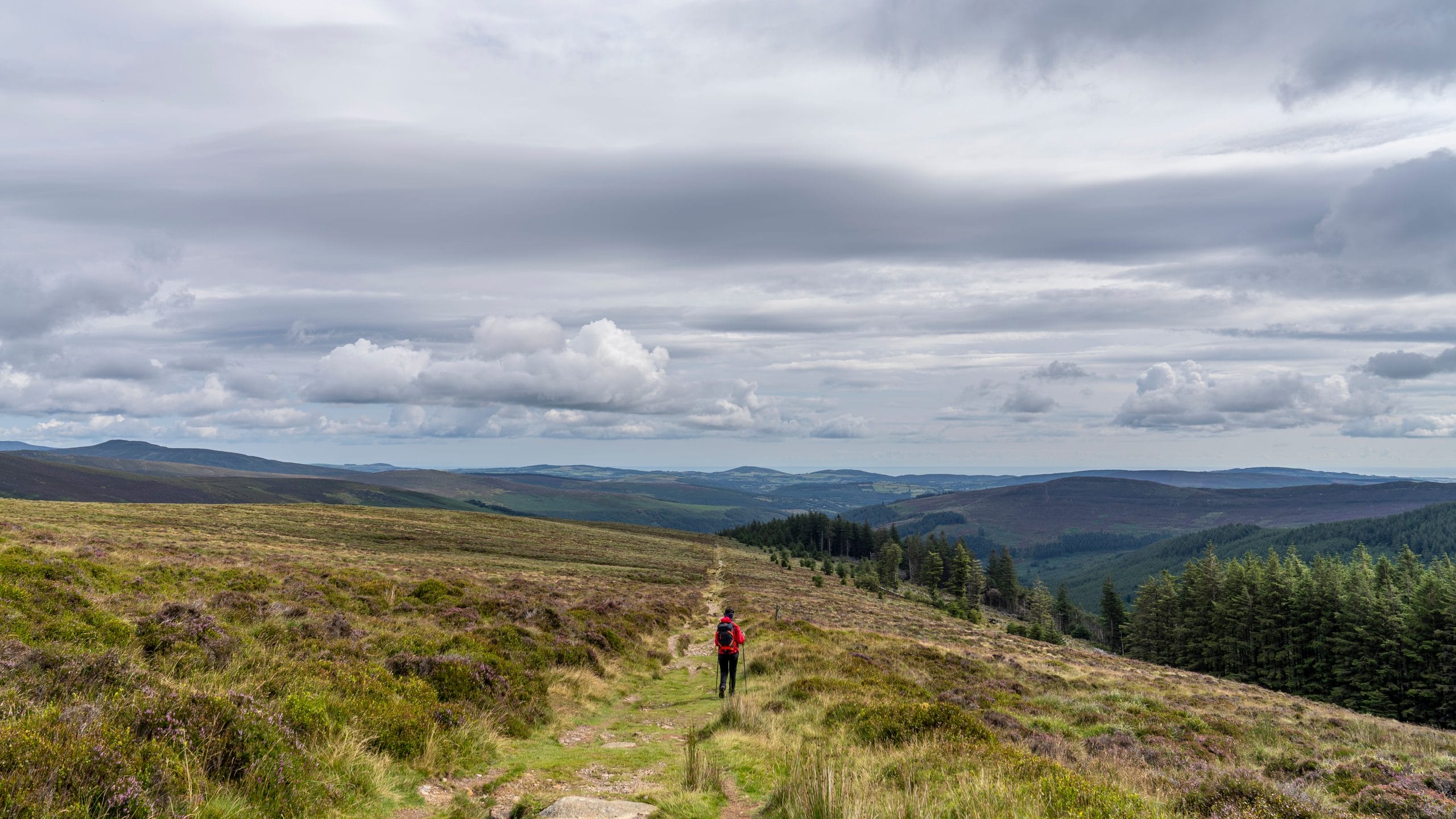
When is the best time to walk the Wicklow Mountains?
When booking a hiking holiday, every season has its own charm, but indeed some months are better for hiking than others. It is always important to make yourself aware of the best times to walk any long-distance trails as weather conditions and busyness can greatly impact your overall hiking experience.
Of course, hours of sunshine, probability of rain, wind and temperature depend solely on the respective season in Ireland.
Due to the longer daylight hours and more favourable weather conditions we recommend that you visit the Wicklow Mountains anytime from March through to October. If you are thinking of completing the Irish trail during the other months of the year, there is a high possibility you will be met with adverse weather conditions including ice, snow, or storms, along with shorter days of daylight.
As a result of the prevailing south-westerly winds along with the warmth provided by the Gulf Stream along the west coast, Wicklow’s climate is mostly mild. If it is sunshine you are looking for, then July and August are often the best months as temperatures range between 14-16C (57-61F). The coldest months in Ireland are January and February with average temperatures ranging from 4-7C (39-45F).
How long does it take to hike the Wicklow Mountains?
As mentioned above, due to its sheer vastness, the Wicklow Mountains is divided up into several trails. Below is an average of how long it would take to complete each of these comfortably while being able to soak up the spectacular surroundings:
The Wicklow Way: 7-10 days
Glendalough Loop: Approximately 3 hours
Trooperstown Hill: Approximately 3 hours
Avonmore Way: Between 3-4 hours
St. Kevin’s Way: 4-5 days
Tour Route
Types of Trails
Choosing the right hiking tour for you can be, at times, tricky. It is always important to consider your own physical capability and comfort levels.
For example, at Hillwalk Tours, we have grouped each trail route we offer into three categories depending on personal preference and fitness levels. These are – gentle, moderate, and challenging. Each of these categories, depending on the destination, will include anything from 4 to 13-day itineraries, with customers given the option to add rest days where they see fit.
Our gentle hikes are perfectly suited for those who would consider themselves as a part-time hiker who enjoys taking photos and meeting locals while taking in the spectacular scenery. Our moderate hikes will suit people who are used to regular exercise and appreciate the opportunity of covering plenty of ground each day without going beyond their limits. Finally, our challenging hikes are for hikers who look to set off early in the morning and not stop until they have reached their destination.
With regards to our Wicklow Mountains trails, we offer 4 to 10-day gentle, moderate and challenging hikes. Each of these hiking categories cover the following average hiking distance and time each day:
Gentle: 12-16km or 8-10 miles and between 4-5 hours per day
Moderate: 15-19km or 9.5-12 miles and between 5-7 hours per day
Challenging: 22-27km or 14-17 miles and between 6-8 hours per day
Hillwalk Tours Guide Notes
If you decide to walk the trail with Hillwalk Tours, you will receive a detailed walking pack once you have fully booked your hiking holiday. This walking pack will include detailed Ordnance Survey (OS) maps and unique route notes and walking directions written and constantly updated by our route development team. By personally walking each trail and creating our own detailed route notes, it allows us to provide more itineraries, route options and alternatives than what you will typically find across generic guidebooks. It also includes GPS tracks meaning you will never have to worry about getting lost.
Starting and Finishing Point
The following are the starting and finishing points to each of the routes along the Wicklow Mountains:
The Wicklow Way
Most of our tours on the Wicklow Way hike the route from south to north (towards Dublin). That way, the sun and much of the wind and rain will be in your back instead of in your face. This also has the advantage that most of the travelling is done on the first day and when walkers finish their tour, they are closer to Dublin City centre. The Wicklow Way starts in the small village of Clonegal in County Carlow and for the first 50km it crosses a series of gentle foothills. The route then enters the central Wicklow Mountains, with its high rounded ridges and deep valleys. Much of this section is covered in forestry and the landscape often changes when trees get felled or replanted. The route passes through the remote and wild glacial valley of Glenmalure, the longest of its kind in Ireland and Britain, before entering beautiful Glendalough with its ancient monastic site. From there, the trail moves deeper into high, heathery moorland, often with wide vistas over the glens and mountains, before finishing in the southern suburbs of Dublin. The Wicklow Way was originally designed to lead through the mountains from one remote inn or hostel to the next and the route does not pass through any villages or towns. While the trail is never really far from a public road, there is a strong sense of remoteness on many of the hikes and transfers are often required between the trail and the overnight accommodation. It is a richly varied route, with the more dramatic scenery of mountains and lakes at the northern end.
Glenealo Valley and the Spinc (Glendalough Loop Walk)
This is a popular walk that gives easy access to some of the most spectacular scenery in Wicklow. After a visit to the peaceful valley of Glendasan it follows the Miners Road in Glendalough to the old ‘miner’s village’. An invigorating climb leads to a bridge at the top of the valley from where hundreds of wooden steps lead to a ridge above the lake with spectacular views back towards Glendalough. Descend is via the Poulanass Waterfall to the two lakes and the monastic village.
Trooperstown Hill
A gentle walk south from the village of Laragh leads through mixed woodland and then up to the top of Trooperstown Hill from where hikers often have wonderful views of the Wicklow Mountains and towards the sea in the east. The route descends through Trooperstown Wood and across the Avonmore River on its way to Laragh.
Avonmore Way
The route follows the Avonmore River from the village of Rathdrum through the beautiful Claravale Nature Reserve. From the picturesque settlement of Clara with its ancient bridge the trail climbs through forests to a road with views of the valley. You can choose to climb Trooperstown Hill before descending through more forest and across the Avonmore River on your way into Laragh.
St. Kevin’s Way
This hike follows in the footsteps of medieval pilgrims who walked to the ancient monastery at Glendalough. The trail climbs gently towards the spectacular Wicklow Gap with its reservoir and hydroelectricity plant. The route passes reminders of a rich mining heritage before it follows the descent of the Glendasan River and a peaceful river walk leads into the Valley of Glendalough.
Sample Wicklow Mountains Itineraries
The following are examples of Hillwalk Tours Gentle, Moderate and Challenging itineraries of hiking the Wicklow Mountains:
Gentle 6-Day (Heart of Wicklow)
Day 1: Arrival in Rathdrum
Day 2: Rathdrum – Laragh (Avonmore Way) (11-17km or 6.8-10.6 miles)
Day 3: Glenealo Valley and the Spinc (13km or 8.1miles)
Day 4: Ballinagee – Glendalough (St. Kevin’s Way) (12km or 7.5 miles)
Day 5: Roundwood – Enniskerry (17km or 10.6 miles)
Day 6: Departure from Enniskerry
Gentle 7-Day (Wicklow Way)
Day 1: Arrival in Rathdrum
Day 2: Ironbridge – Glenmalure (13km or 8.1 miles)
Day 3: Glenmalure – Laragh (14km or 8.7 miles)
Day 4: Glenealo Valley and the Spinc (13km or 8.1 miles)
Day 5: Laragh – Roundwood (12-15km or 7.5-9.3 miles)
Day 6: Roundwood – Enniskerry (17km or 10.6 miles)
Day 7: Departure from Enniskerry
Moderate 8-Day (Wicklow Way)
Day 1: Arrival in Tinahely
Day 2: Tallon’s Pub – Moyne (16km or miles)
Day 3: Moyne – Glenmalure (22km or 13.7 miles)
Day 4: Glenmalure – Laragh (14km or 8.7 miles)
Day 5: Glenealo Valley and the Spinc (13km or 8.1 miles)
Day 6: Laragh – Roundwood (15km or 9.3 miles)
Day 7: Roundwood – Enniskerry (17km or 10.6 miles)
Day 8: Departure from Enniskerry
Challenging 8-Day (Wicklow Way)
Day 1: Arrival in Bunclody
Day 2: Clonegal – Tallon’s Pub (25km or 15.5 miles)
Day 3: Tallon’s Pub – Iron Bridge (26km or 16.2 miles)
Day 4: Iron Bridge – Laragh (29km or 18 miles)
Day 5: Glenealo Valley and the Spinc (13km or 8.1 miles)
Day 6: Laragh – Enniskerry (26-29km or 16.2-18 miles)
Day 7: Enniskerry – Marley Park, Dublin (22km or 13.7 miles)
Day 8: Departure from the Dublin Area
Moderate 10-Day (Wicklow Way)
Day 1: Arrival in Bunclody
Day 2: Clonegal – Shillelagh (20km or 12.4 miles)
Day 3: Shillelagh – Tinahely (21km or 13 miles)
Day 4: Tinahely – Iron Bridge (20km or 12.4 miles)
Day 5: Iron Bridge – Glenmalure (13km or 8.1 miles)
Day 6: Glenmalure – Laragh (via the Spinc and Glenealo Valley (16km or 9.9 miles)
Day 7: Laragh – Roundwood (15km or 9.3 miles)
Day 8: Roundwood – Enniskerry (17km or 10.6 miles)
Day 9: Enniskerry – Marlay Park, Dublin (22km or 6-8 miles)
Day 10: Departure from the Dublin Area
Currency and Expenses
The currency used throughout Ireland is the Euro (€).
The cost of food, drinks, and activities while hiking in the Wicklow Mountains can vary based on several factors, including the type of establishment, the time of year, and personal preferences.
Dining out in restaurants in areas around the Wicklow Mountains can range from affordable to moderately expensive, depending on the cuisine and the restaurant. A meal for one person in a mid-range restaurant typically costs around €15 to €30, excluding drinks. If you prefer more upscale dining experiences, prices can be higher. The cost of drinks, such as a pint of beer or a glass of wine, can range from €4 to €8, depending on the establishment. Prices may be higher in popular tourist areas, especially during peak seasons.
The Wicklow Mountains area offers visitors a variety of activities, including hiking, exploring historical sites, and taking scenic drives. The prices for these activities can vary. It’s important to note that prices in the Wicklow Mountains may be higher during the peak tourist season (typically June, July, and August) compared to the off-peak season.
Wicklow Mountains Accommodation and Services
Hotels and Guesthouses
There are several hotels and guesthouses available throughout the Wicklow Mountains, particularly in towns and villages such as Clonegal, Tinahealy, Glenmalure, Laragh, Roundwood, Enniskerry, and near Marlay Park. These establishments offer comfortable rooms, dining facilities, and amenities for travellers.
Bed & Breakfasts
B&Bs are a popular choice in the Wicklow Mountains, providing cosy and affordable lodging options. They offer comfortable rooms, breakfast, and often have friendly hosts who can provide local information and tips for your journey.
Hostels
For budget-conscious travellers, there are hostels scattered across the region. These establishments usually provide dormitory-style accommodations and communal facilities such as kitchens and lounges.
Camping and Glamping
If you prefer camping, there are designated campsites available throughout the Wicklow Mountains. These sites typically provide basic amenities such as toilets, showers, and sometimes cooking facilities. Some popular campsites in the area include Lough Dan, Hidden Valley, and Roundwood Caravan and Camping Park.
Wild camping in the Wicklow Mountains, although not prohibited by law, requires careful consideration due to the exposed terrain, potential for strong winds and rain, and the need for appropriate equipment to endure Ireland’s unpredictable weather. Also, authorities around the area do ask campers of all kinds to not camp in Glendalough.
You can also discover the perfect blend of luxury and nature in the Wicklow Mountains with an array of glamping options at your disposal, offering stylish tents and cosy cabins nestled amidst breathtaking landscapes.
Airbnb and Self-Catering
Airbnb accommodations offer a diverse range of options in the Wicklow Mountains, from cosy cottages to secluded retreats, providing a unique and personalized experience for hikers. For example, some properties offer stays on working farms, allowing visitors to immerse themselves in rural settings and witness farm life up close.
Restaurants and Cafes
Along the trail and in towns and villages, you’ll find numerous restaurants, cafes, and pubs where you can enjoy a meal, snack, or a refreshing drink. These establishments serve both local and international cuisine, including traditional Irish dishes. Most restaurants and cafes will also be able to meet several dietary requirements.
Shops and Grocery Stores
In the towns and villages throughout the Wicklow Mountains, you’ll find grocery stores and shops where you can stock up on food, water, and other supplies for your journey. It’s advisable to plan ahead and carry snacks and water while hiking between settlements.
ATMs
There are ATMs available in towns and villages along the route, including Clonegal, Tinahealy, Glenmalure, Laragh, Roundwood, Enniskerry, and near Marlay Park. However, it’s important to note that the availability of ATMs may be limited, especially in smaller villages or remote areas. To ensure you have enough cash for your journey, it’s advisable to plan ahead and withdraw sufficient funds in larger towns where ATMs are more readily accessible. Additionally, carrying some cash with you is recommended for places that may not accept cards or in case of any unforeseen circumstances. There is the potential to obtain cashback from certain stores. This means that when making a purchase with your card, you can request additional cash on top of your payment. However, it’s worth noting that not all stores offer this service, and the maximum amount of cashback might vary.
Wicklow Mountains Trail Etiquette
The Wicklow Mountains are renowned for their stunning natural beauty and commitment to environmental preservation. Local communities in Wicklow place great importance on preserving the region’s landscapes and wildlife. Respect for the environment, responsible tourism, and adherence to trail etiquette are highly valued when hiking in the Wicklow Mountains.
When exploring the Wicklow Mountains, it is essential to follow the principles of the Leave No Trace organization. Practicing responsible hiking involves refraining from littering or leaving behind any waste, including fruit peels, wrappers, or other non-biodegradable items. Hikers are expected to carry out all their trash and dispose of it properly in designated bins or take it with them until they find appropriate disposal facilities. By embracing the Leave No Trace principles, hikers contribute to the preservation of the pristine beauty of the Wicklow Mountains and help ensure its enjoyment for future generations.
At Hillwalk Tours, we proudly support sustainable tourism and have a deep appreciation for the wild, peaceful, and clean countryside of the Wicklow Mountains. We are committed to promoting the “Leave No Trace” initiative, which aims to preserve the natural beauty of the Wicklow Mountains and other locations where we offer hiking holidays.
Hillwalk Tours Wicklow Mountains Map
The Wicklow Mountains Terrain
Waymarking
Each trail along the Wicklow Mountains are well sign-posted throughout their entirety. You will regularly see a yellow arrow throughout one of Ireland’s longest trails which will help indicate your every next turn, making it significantly difficult for you to get lost or take the wrong turn.
If you are ever in doubt, you can also check the Hillwalk Tours turn by turn directions and route notes including GPS coordinates. We also supply all you need to know about local information and history as you pass, along with trail alternatives and other activities.
Want to learn more about how to read a map? Check out this blog post.

Difficulty
The terrain on the Wicklow Way consists of forestry tracks, quiet country roads, green boreens (an Irish word that literally translates as ‘little road’) and mountain paths through open moorland. Some sections can occasionally be wet and muddy, but many of those have been improved by wooden boardwalks.
Large sections of the route follow gravel tracks through land owned by Coillte, a state owned forestry company. This means that the landscape along those sections is often changing as trees get felled, are replanted, grow and then reach maturity as tall trees within the cycle of commercial forestry.
Approx. 39km or 30% of the total Wicklow Way route follows local roads, to avoid walking on private land. But this percentage can be much lower, depending on which tour itinerary you choose. In general, there is more road walking in the southern part of the route.
Since our Wicklow Mountains tours lead through a vast landscape of hills and mountains there is naturally a fair amount of ‘up and down’ in all itineraries and as part of every hiking day. The total aggregate ascent is approximately 3,300m over the entire route and there are some steep sections with longer climbs. The highest point is at White Hill, near Lough Tay, where the trail reaches a little over 600m.
Sights & Attractions
Glenmalure
This 20km long glacial valley can be found in the southern section of the Wicklow Mountains and was formed during the last Ice Age. The U-shaped valley is also one of the longest glacial valleys in Ireland and presents walkers with breath-taking scenery.
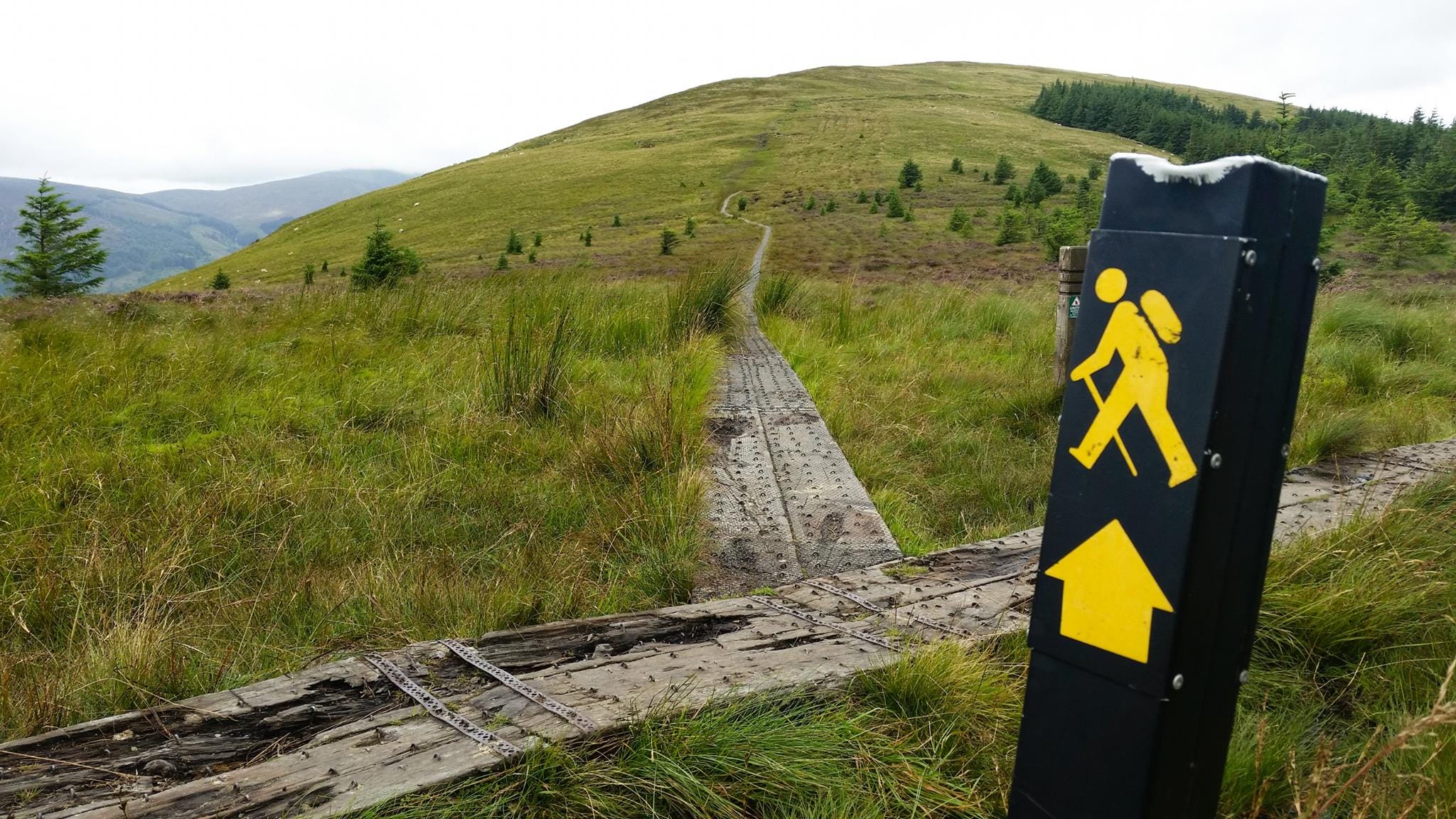
Glendalough Monistic Village
St. Kevin founded the monastic site at Glendalough in the 6th century. It remained as one of the most important monastic sites in Europe for six centuries after St. Kevin’s death (618 A.D.). The site remains in excellent condition today with stone churches, crosses and a 33m-high round tower. This tower was used by the monks to hide from invading Vikings, and to protect their precious manuscripts. The doors of round towers are raised 2 to 3 metres off the ground, meaning entry is only possible with a ladder. This would have been pulled up after the the monks were inside.

Lough Tay (Guinness Lake) and Luggala Estate
Like Glendalough, Lough Tay is one of the most photographed locations throughout the Wickow Mountains and iconic location in Ireland. It nestles between the mountains of Djouce and Luggala, Lough Tay (locally known as the Guinness Lake) is one of the most beautiful places in Wicklow Mountains National Park. Not only does the dark waters and white sand beach resemble a pint of Guinness, the lake and its surrounding areas were once owned by the Guinness family for almost 100 years!
Surrounded by trees at the north end of Lough Tay you will find Luggala Lodge one of Ireland’s most storied estates with a deep connection to music. Built as a hunting lodge in 1787 by Peter LaTouche (founder of the Bank of Ireland) it was modelled on Strawberry Hill House in Richmond, London. Purchased by the Guinness family in 1937 the estate was later owned by arts patron Garech Browne, the great-great-great-grandson of Arthur Guinness. The founder of Claddagh records he was a pivotal figure in the renaissance of Irish traditional music in the 1970’s.

His brother, Tara Browne, a key socialite in London’s swinging 60’s, died aged 21 in a car accident and is buried on the grounds. His death was the inspiration for the Beatles’ song “A Day in the Life“. Marianne Faithfull reportedly said the news was “like a death knell sounding over London.” According to reports, Browne swerved the car so that he would take the impact allowing his passenger Suki Potier to survive. 6 Months earlier Browne flew 2 planeloads of guests to Luggala for his 21st birthday party, including John Paul Getty, Mick Jagger and Brian Jones. Music at the event was provided by the Lovin Spoonful. Paul Howard’s 2016 book “I Read the News Today, Oh Boy” recounts this short but eventful life.
Hillwalk Tours Tip: The best views of the lake can be seen at the summits that surround it!

Powerscourt Estate and Waterfall
The Powerscourt Estate dates back to the 12th century. By 1300, the Power family, its namesake, had built a castle on the grounds. Through several change of family ownership, each generation made their own improvement to the house and grounds, making it into what it is today – one of Europe’s great garden treasures.
Powerscourt Waterfall, then, is one of the highest waterfall in Ireland, at 121m (398 ft.). It’s located roughly 6km from the Powerscourt Estate but can easily be viewed from the Wicklow Way trail. The trees in the park surrounding the waterfall were planted 200 years ago. The giant redwoods there – native to California – can grow to be 4,000 years old!

Avonmore House and Forest Park
Avonmore House was built in 1777 and the estate was early on planted with a wide range of tree species from all over the world. It is considered the birthplace of Irish forestry and the house is set in a magnificent 500 acres of forest park near the town of Rathdrum. One of Ireland’s greatest political figures, Charles Stewart Parnell, was born in Avonmore House in 1846 and today, the house is a museum dedicated to him.

Clara Vale Nature Reserve
This nature reserve contains the largest area of semi-natural woodland in Wicklow and is arguably one of the largest stands of native hardwoods in Ireland. The oak-woods are of high scenic value and a must-see for walkers and hikers alike!
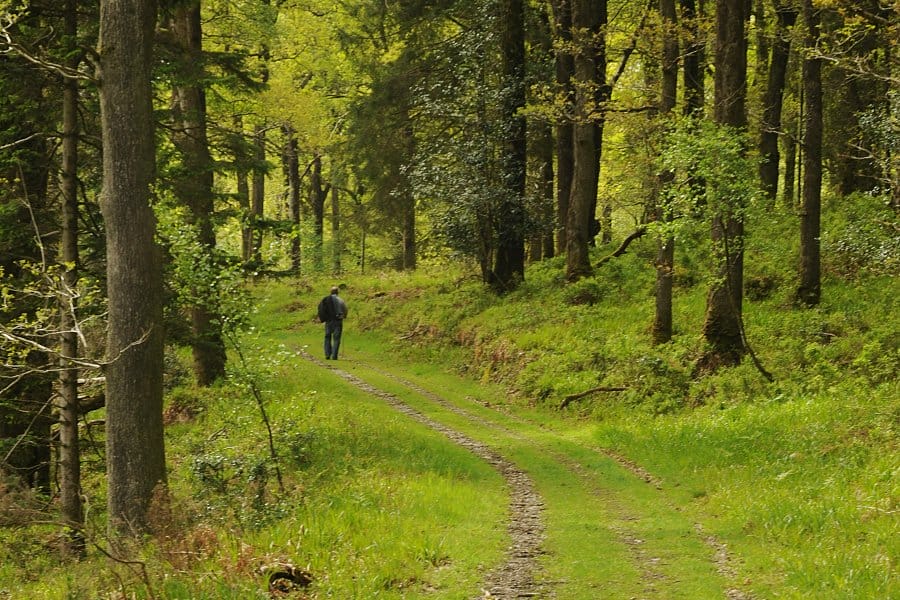
Djouce
At over 700 meters, the Djouce is one of the highest peaks in the Wicklow Mountains. The view from this mountain is therefore phenomenal as it looks out over the surrounding green valleys, mirrored lakes and continuous rolling hills.
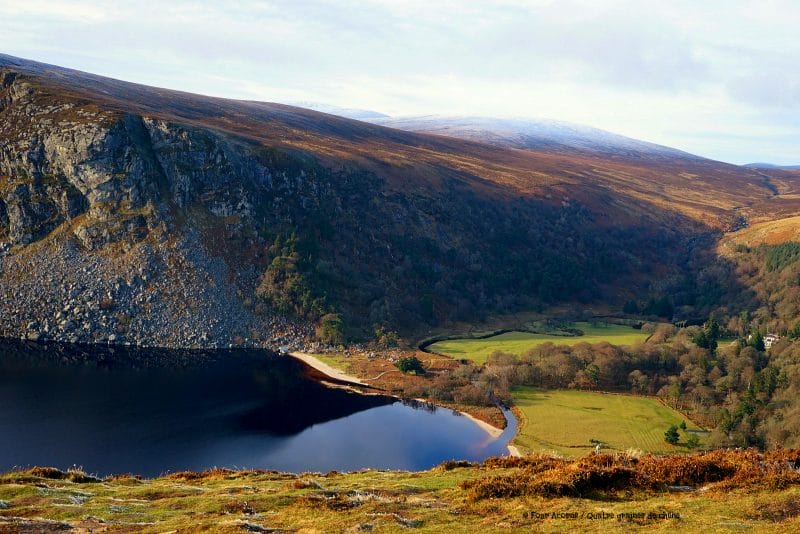
Ballinastoe Woods
A stone throw from Lough Tay, is the beautiful Ballinastoe Woods. The incredible views of the Guinness Lake and the mountains beyond make it a must-visit part of the trail, with ample opportunity for those who love to take photographs!
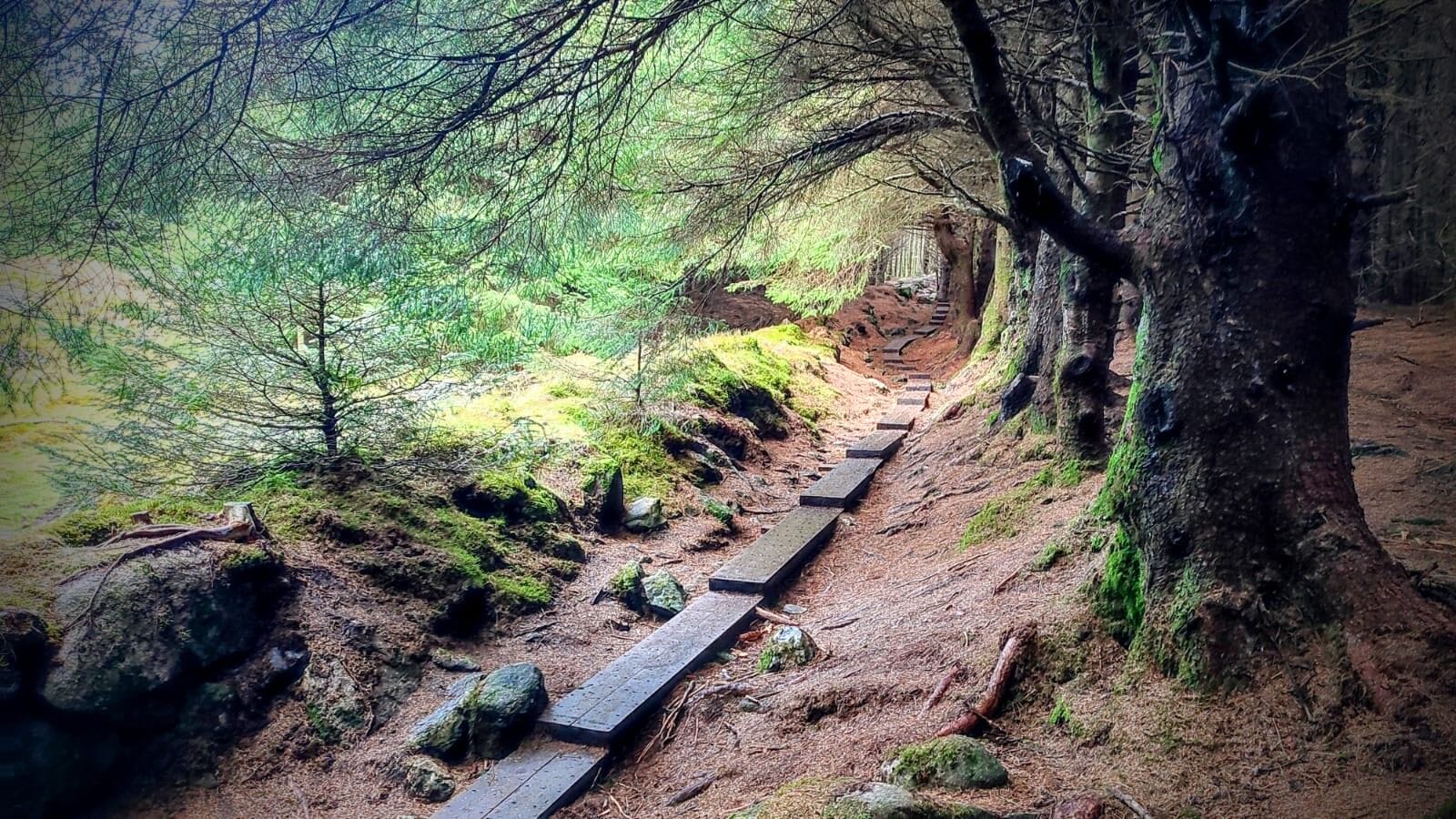
Glenmacnass Waterfall
Glenmacnass Waterfall with its 80-meter cascade runs down a rugged hillside to the scenic beauty of a picturebook valley below. Unlike the towering Powerscourt Waterfall, Glenmacnass holds its own charm at 350m in height. It draws rapt visitors into its tranquil surroundings with the imposing Mullaghcleevaun to the west where its river begins. People travel from afar to experience its sense of isolation which adds to the mystique of this natural wonder.
So, while Powerscourt may impress with its height, it’s Glenmacnass Waterfall that truly captivates, with its deeply defined valley beyond. Chase your waterfall on one of our Wicklow Mountains tours and be sure to have your cameras ready to capture its magic.
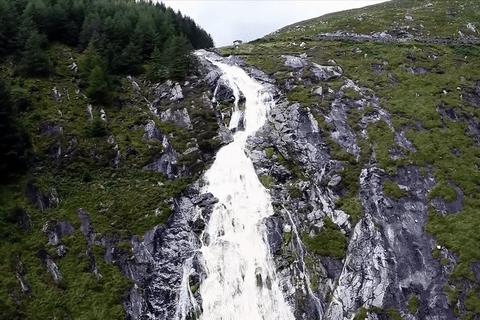
Wildlife
Wildlife is plentiful along the Wicklow Mountains with a vast array of mammals and birds species on show including red squirrel, pine martins, foxes, eagles, crossbills and the wood warbler.
It is of course great to get up close and personal with any of these animals. However, to maintain these experiences as much as possible, it is important that hikers interact as little as possible with the wild animals.
The do’s and don’ts regarding wildlife are, as always, self-explanatory. Feeding is of course out of the question, but also try not to run after animals for photos. Leave the animals alone as much as possible – after all, you are visiting their “home”.
History of the Wicklow Mountains
Over 400 million years ago, the North American and European plates collided causing the land beneath the sea to collide and buckle upwards. This land buckled up above sea level and formed what we know as the Wicklow Mountains.
Their current shape and formation is largely due to the results of the last ice age around 2.5 million years ago. It was during this time that glaciers eroded and deepened the existing valleys and created many lakes throughout the area.
The Wicklow Way is Ireland’s oldest waymarked trail and its origins date back to 1966 newpaper articles by famous hill walker, J.B. Malone before becoming an official trail in 1982.
Did you know?
Wicklow is colloquially known as the ‘Garden County’ or the ‘Garden of Ireland’ for its scenery of vast woodlands, rolling hills and majestic mountains that allow for some of the best walking and hiking options in Ireland.

The People & Local Customs
The people of Wicklow are renowned for their warm and welcoming nature. It is customary to greet others with a smile, engage in friendly conversations, and exhibit genuine friendliness towards both locals and visitors. Hospitality holds great importance, and it is not uncommon to find locals offering their assistance or engaging in pleasant conversations. County Wicklow boasts a vibrant musical heritage, with traditional Irish music playing a significant role in local customs. Numerous pubs along the Wicklow Way often host lively music sessions, creating an inviting atmosphere for all to enjoy. The residents of Wicklow take great pride in their cultural traditions, encompassing music, dance, and storytelling, which contribute to the vibrant tapestry of the community.
Wicklow Mountains Pop Culture
Film and TV
| Tucked away amidst the dramatic landscapes of County Wicklow, also known as the Garden of Ireland, lies a movie makers paradise surrounded by wild beauty and rugged mountains. Wicklow, Ireland’s own Hollywood, has captured the imaginations of filmmakers seeking to create tales of love, adventure, and historical drama against the stunning scenery. |
| With the establishment of Ardmore Studios in 1958 many famous films have been shot in the area including My Left Foot, Excalibur and Michael Collins. The Wicklow Mountains have provided the perfect setting for classic cinematic moments such as the romance of Gerry and Holly in P.S. I Love You. Other movies which have also utilized the county’s natural beauty to transport viewers to different eras include Braveheart and the TV series The Tudors. Additionally, the popular historical drama Vikings was predominantly filmed in Wicklow with Lough Tay serving as the location for the iconic Viking settlement of Kattegat. |
Bodkin (2024)
Bodkin, Netflix’s latest series produced by Barack Obama, follows a group of podcasters investigating the mysterious disappearance of three strangers in an idyllic Irish town. It is filmed around various locations in Ireland, including the picturesque setting of Lough Tay in Wicklow. The film crew captured the natural beauty of the Irish landscape, utilizing Lough Tay as a backdrop for some scenes.
Irish Wish (2024)
This popular Netflix romcom, starring Lindsay Lohan, follows Maddie, who is a bridesmaid-to-be at the wedding of her dream man, Paul Kennedy. Irish locations play a prominent role throughout the movie, hence the title. Lough Tay stands out as one of the movie’s prominent settings, serving as the place where Maddie makes a wish to marry Paul at the site’s ‘wishing chair’. Wicklow features prominently throughout the movie, with locations such as Killruddery House and Powerscourt Estate also being used.
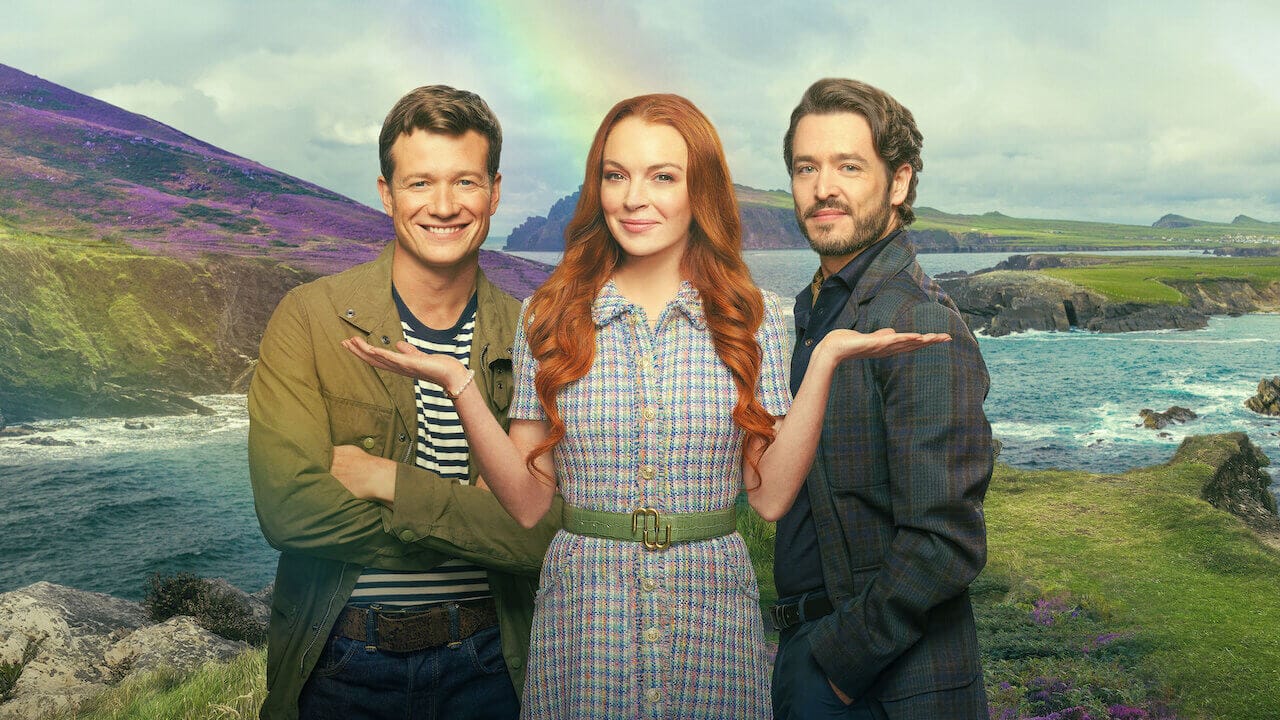
Michael Collins (1996)
This famous biographical period drama, starring Liam Neeson, depicts the story of the famous Irish freedom fighter and politician, Michael Collins as he leads Ireland’s struggle for independence against British rule (early 20th-century). Although most of the film was shot in Dublin, parts of the Wicklow Mountains were used for more scenic shots including the ambush and death of Collins.
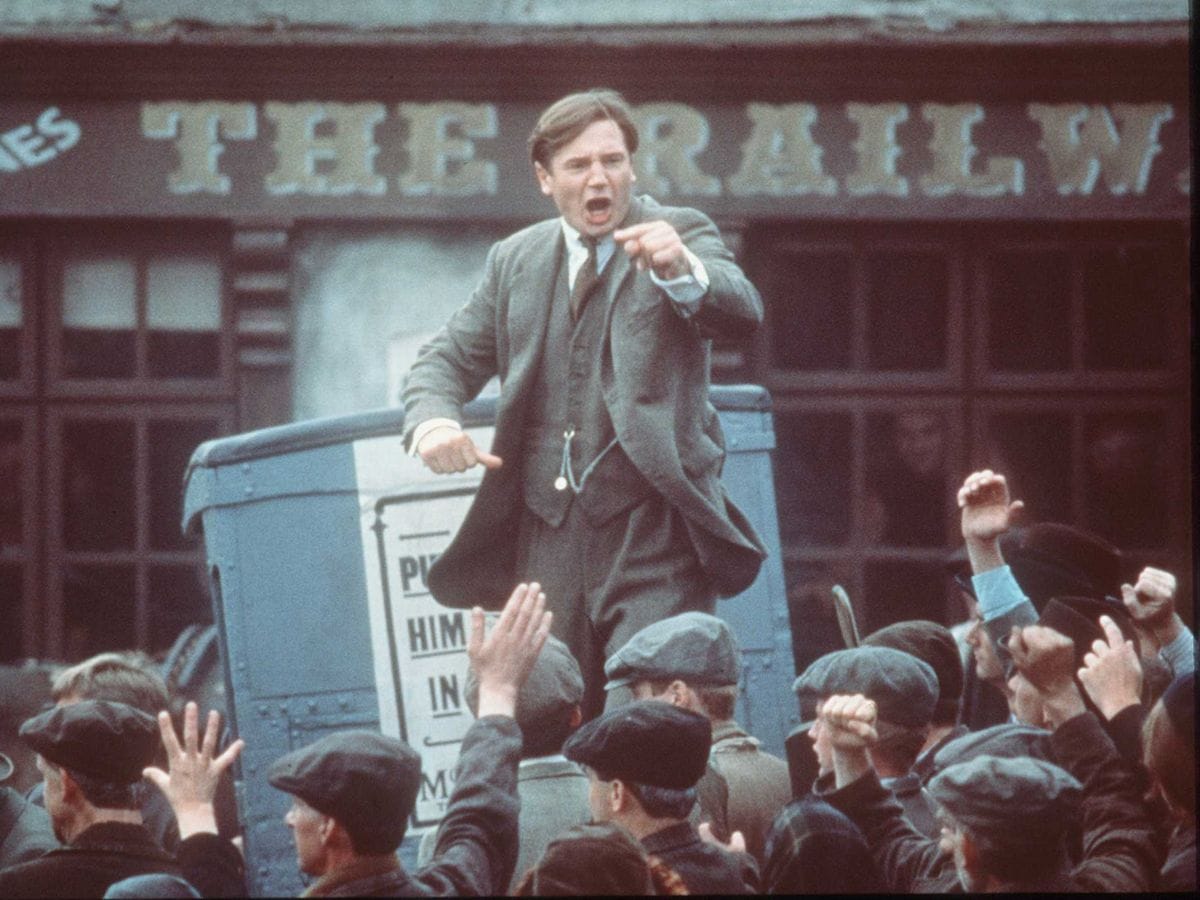
P.S: I Love You (2007)
In this film adaption of the famous novel, the Wicklow Mountains are used in a scene where Gerry (Gerard Butler) and Holly (Hilary Swank) meet for the very first time before falling deeply in love.

Braveheart (1994)
It is sometimes easy to forget that several scenes from this epic Oscar-winning film was shot in Ireland. Many of the battle scenes and spectacular panoramic scenes were shot on location in the rolling hills and scenic valleys of the Wicklow Mountains.
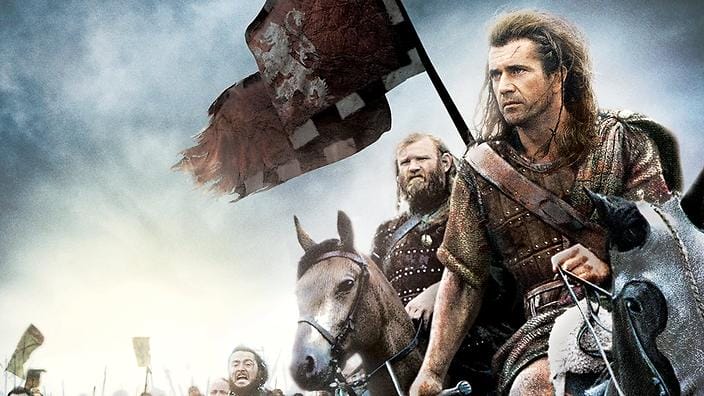
Vikings (2013-2020)
When watching Vikings, you would be easily forgiven for thinking the series was filmed somewhere in Scandinavia. Nope! Almost the entirety of every season was filmed in Wicklow, where the small country has been transformed to England, France and Norway depending on the scenes. Kattegat, the home of Ragnar Lothbrok, the series central character, is actually Lough Tay and its surrounding areas!
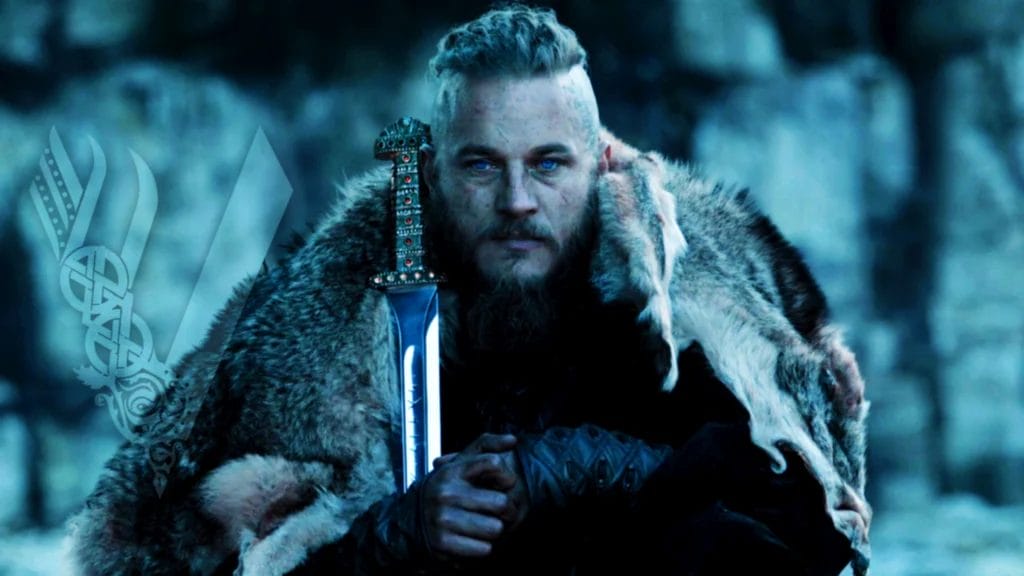
The Tudors (2007-2010)
The Tudors was one of the most successful TV shows of its time as it told the story of Henry VII and the foundation of the Church of England. Not only did Irish man, Jonathan Rhys Meyers, play King Henry but 80% of the series was filmed throughout the Wicklow countryside.
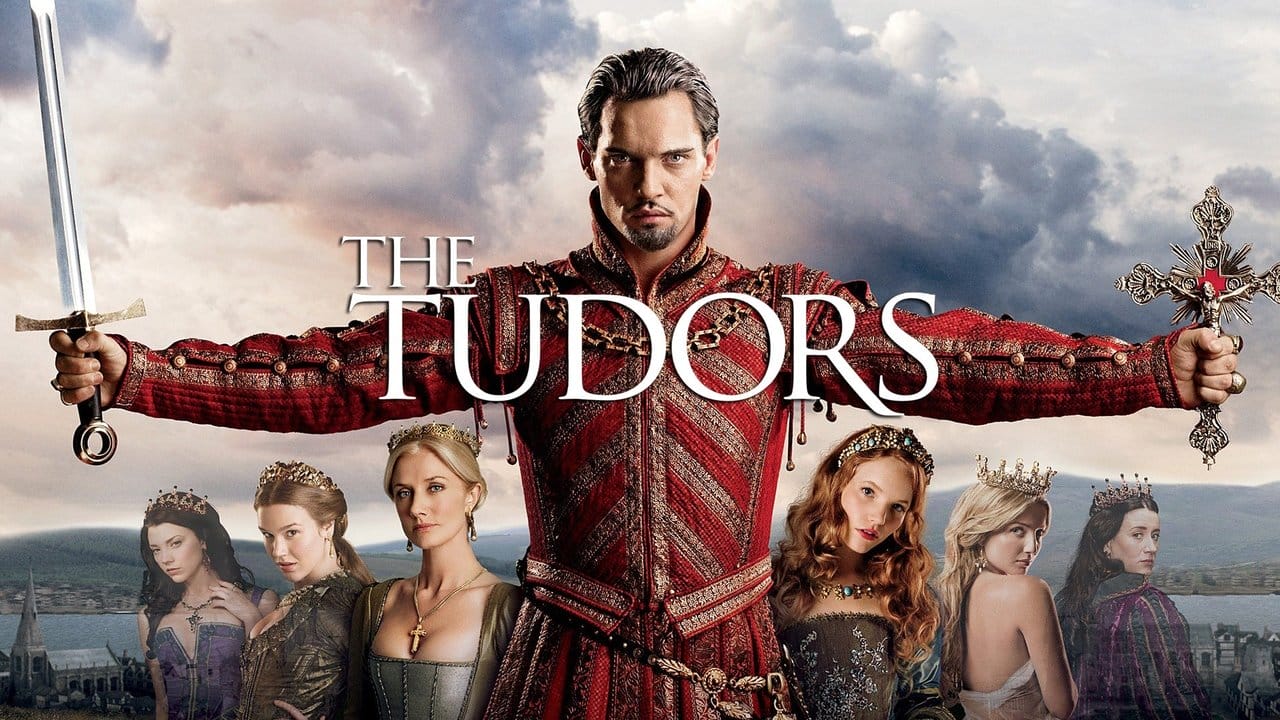
Books
Wicklow Bound: A Seasonal Guide by Sean O’Suilleabhain
Each chapter of this magnificent guide covers a different month of the year while detailing the subtle yet awe-inspiring changes to the flora and fauna found throughout the Wicklow Mountains. With beautiful imagery of landscapes and wildlife, this comprehensive guide also gives suggestions for walks, viewing points and information regarding its local history.
The Mystery of Four by Sam Blake
Continuously referred to as the Irish version of ‘Agatha Christie’s Midsomer Murders’ this crime novel is set in a house and gardens in Powerscourt, right up in the Wicklow Mountains.

Food and Drink
Below are just some of the food and drink synonymous with the country of Ireland that should be tried while walking the Wicklow Mountains:
Irish Stew
A typical Irish dinner if there ever was one. A classic Irish stew contains beef or lamb with vegetables such as potatoes, onions and carrots. This is a perfect, nutritious dish for those that hike as it will fuel you throughout the day and also keep you warm. Don’t be surprised if you see a beef stew made with Guinness!

Full-Irish Breakfast
A full-Irish breakfast is typically made up of sausages, bacon, black and white pudding, eggs, baked beans, mushrooms, grilled tomatoes and bread. Irish soda bread is used mostly (see below) and it is typically accompanied by lots of tea or coffee. If you are in a hurry, go to a local shop and get a breakfast roll – whereas many of the above ingredients are added into a fresh baguette. You really have not lived if you haven’t tried one of these!

Black and White Pudding
Yes, we knew some of you might be wondering what pudding refers to… it is popular throughout Irish cuisine. Pudding is basically sausage meat blended with oats or barley. There is a significant difference with black and white pudding as black pudding contains blood whereas white pudding doesn’t.
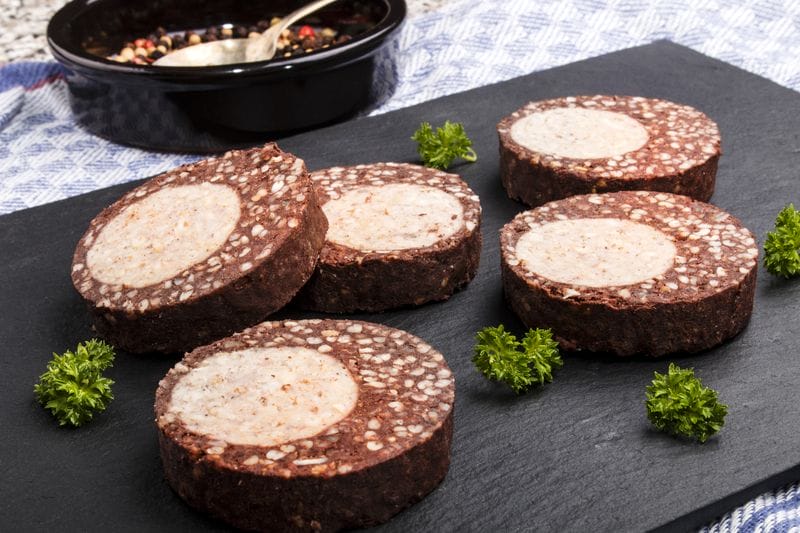
Seafood
Ireland is renowned for its superb and fresh quality seafood. From fresh fish to shellfish, Ireland is a big producer and exporter of seafood. Examples of this fabulous seafood includes salmon, monkfish, pollock, hake, oysters, prawns and mussels. For all of you fish and chips lovers out there, you have not lived until you have tried an Irish fish and chips from a local ‘chipper’.
Seafood Chowder
Seafood Chowder is a hearty soup made with seafood, vegetables and cream and is a popular meal throughout the pubs and restaurants of Ireland. It usually contains fish such as salmon, white fish, and prawns mixed with onions, potatoes, swede and cream. It is typically served with homemade brown bread and is another dish that will keep you full throughout the day!

Bacon and Cabbage
This dish of sliced back bacon boiled together with cabbage and served with potatoes (some form of white sauces optional) has long been a traditional dish of Ireland. This is because each of the ingredients were readily available as they grew their own cabbage and reared their own pigs. You’re trip to Ireland is incomplete until you have tried this typical Irish dish!
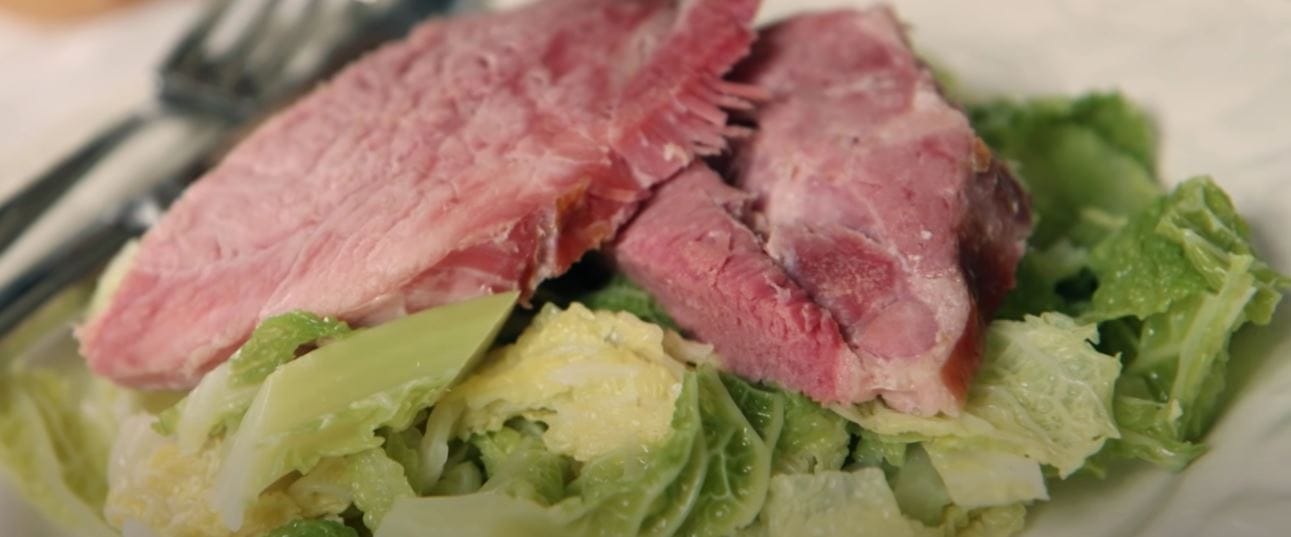
Shepard’s Pie
Possibly Ireland’s most beloved ‘comfort’ dishes, Shepherd’s Pie is made with a layer of ground beef or lamb and veggies, and is topped with creamy mashed potatoes before being baked to perfection. The dish actually originated in Scotland where crust was used in place of potatoes. However, once it arrived to Ireland, potatoes were quickly opted for instead, and the dish has become a household favourite throughout the country.

Guinness
Did you even go to Ireland if you didn’t have a pint of creamy Guinness? This dark stout is made from barley, hops, roast malt extract and water. Some of the barley used is roasted to give Guinness its dark colour and unique lactic acid flavour. Brewed at St. James Gate Brewery in Dublin since the late 18th century, this Irish pint is exported across the world, making approximately $2 billion annually. Any Guinness connoisseurs will tell you, you have not had a Guinness unless you have tasted one in Ireland!
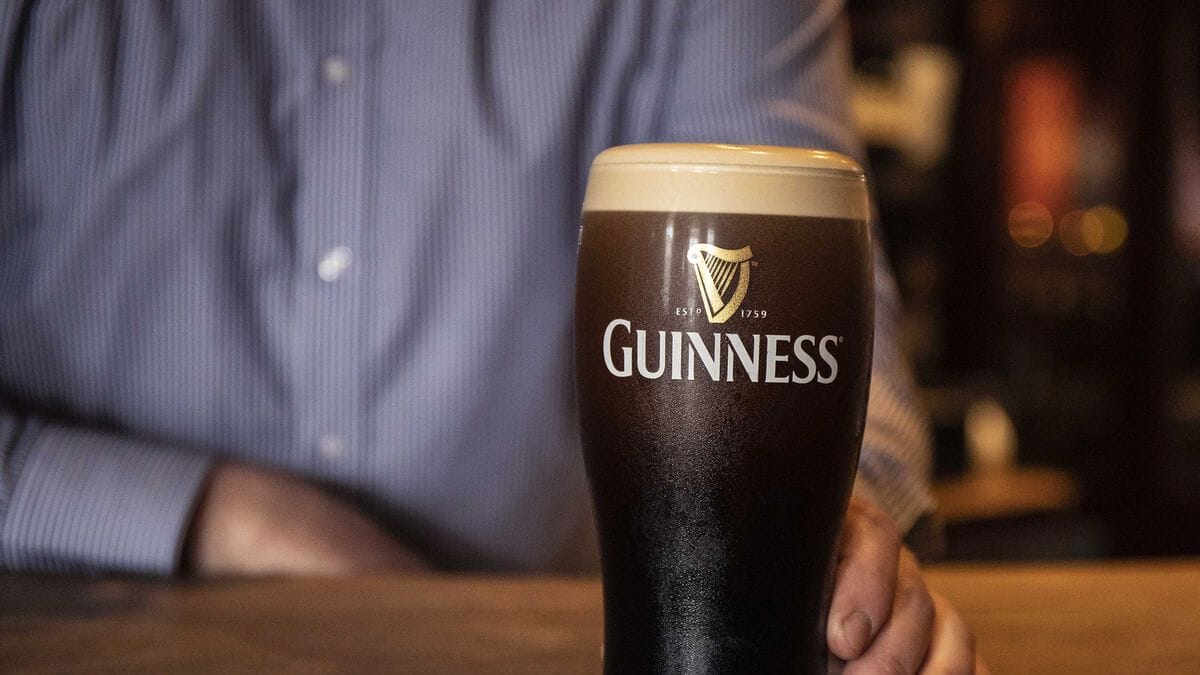
Irish Coffee
No, we aren’t talking about Irish roasted coffee beans here. This is a caffeinated alcoholic drink that consists of whiskey, hot coffee, brown sugar topped with cream. There are plenty rumours about how this hot beverage came to fruition but the most commonly believed story is that a head chef in the restaurant of the Foynes Airbase added whiskey to the coffee of some tired passengers who were awaiting a storm to pass. The rest is history!
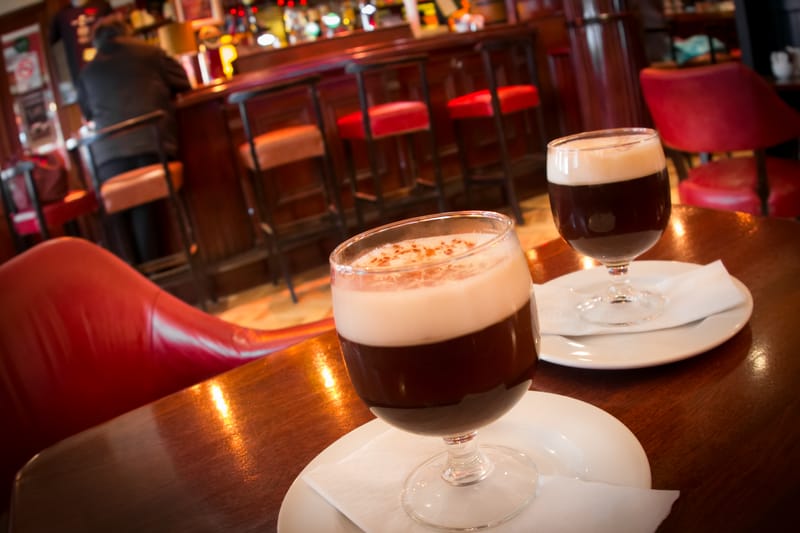
Is the Wicklow Mountains Vegan Friendly
The vegan diet has become more and more popular throughout Europe in recent years, and you will find that there are plenty of vegan options available in most eateries. Each of the accommodation we work with at Hillwalk Tours have given us their guarantee that vegan breakfasts will be catered for once they have been informed. That being said, some of the more rural locations of the trail may have limited options so we advise bringing certain items such as plant-based milk, nut butters or protein powders if you so choose.
In addition, the following apps show restaurants which offer vegetarian and/or vegan options:
Nearby Trails
There are various other Irish trails available to you once you have completed the Wicklow Way. Here are the other Hillwalk Tours Irish hiking tours we offer:
- Dingle Way
- Kerry Way
- Beara Way
- Connemara & the West of Ireland
- Burren Way
- Sheep’s Head Way
- Antrim Glens and Coastline
Wicklow Mountains Tips and FAQs
Probably one of the most common questions asked when walking the Wicklow Mountains or any trail for that matter is – what will I pack?
Once you have fully booked your Hillwalk Tours hiking holiday, you will receive a detailed ‘recommended equipment’ list inside your Walking Pack. For those who are still unsure of what to bring, here are some of the things we advise you bring with you while hiking the Wicklow Mountains:
– Waterproof Clothing
– Fleece and other warm clothing
– Base Layer
– Light, comfortable Trousers
– Wicking Socks
– Suitable Hiking Boots
– Backpack/Rucksack
– Hat and Gloves
– First Aid Kit and Foil Blanket
– Whistle and Torch
– Insect Repellent
– Mobile Phone
– Plug Adapter/Converter
For more on what to pack – check out these packing musts.
As most of the accommodation we work with in this area don’t accept pets of any kind, it is not possible to bring any pets, such as your dog, on a Hillwalk Tours hiking holiday.
As the trail is one of Ireland’s most popular, you will rarely be alone while walking it. You will always meet people along the way with the only exception being during the depths of winter.
As a result of this, the Wicklow Mountains is deemed safe for solo hikers.
Furthermore, conditions at certain points along the trail can be slippery, muddy and wet so general precautions still apply.
If you experience any difficulty or emergency of any kind, it is advised that you phone the relative emergency services on 999 or 112. It is also important to note that mobile phones in Ireland can call this number with or without mobile/cell coverage.
For those who have fully booked their Hillwalk Tours hiking holiday on the Wicklow Mountains, we provide 24/7 on-call support to all of our customers and you will receive a detailed description on how to remain safe during the course of your hike.
Yes, solo hikers are more than welcome to complete the Wicklow Mountains and the trail proves to be quite popular for solo hikers. However, due to the limited availability of single rooms along the trail, it is important to note that booking early is recommended, in addition to a single supplement charge also being applicable.
We believe that the beauty of the Irish countryside should be enjoyed by everyone. With this in mind, we designed our hiking tours to cater for practically all levels of fitness. Our range of ‘Gentle’, ‘Moderate’ and ‘Challenging’ hikes in all regions allows you to decide how far you wish to walk each day and the pace you set. So, whether you are a novice walker or an experienced hiker, we always have a tour to suit you.
As it was predominantly designed as a long-distance walking route, you may come across terrain, underpasses and gates at several parts of the trail making it difficult for biker riders. Therefore, it might be best to leave bike at home this time!
Generally, our tours take place between the months of March to October to hopefully allow for good, dry weather and longer days of daylight while you carry out your tour. This will hopefully ensure that you enjoy your hiking experience with us to the fullest. You can also check out the individual tour page for the Wicklow Mountains trail on our website.
Our 7-Day tours include 5 full days of walking – the first and last days of the tour are treated as travel days which allow walkers to reach the starting point and depart from the finishing point in a calm and comfortable manner.
To ensure you’re fully equipped and informed throughout your trail we provide a very informative ‘Walking Pack that you take with you on your trail. This pack has every detail you will need to successfully finish your trail without any disruption. We advise that you carefully look through this pack before embarking on your journey so that you have some sort of idea of where you’re going and what you will entail throughout the journey. Included in this pack is as follows;
– Route notes (prepared by a member the Hillwalk Tours team who has walked every step of your tour)
– Detailed hiking map(s)
– Waterproof map-case
– A sneak-peak at where you will be staying
– Our tips on the most interesting attractions to visit along the trail
– A look at fascinating local history
– A guide to the best places to eat and drink
– Mountain safety information, emergency contact details & the country code
Wicklow Mountains Image Gallery




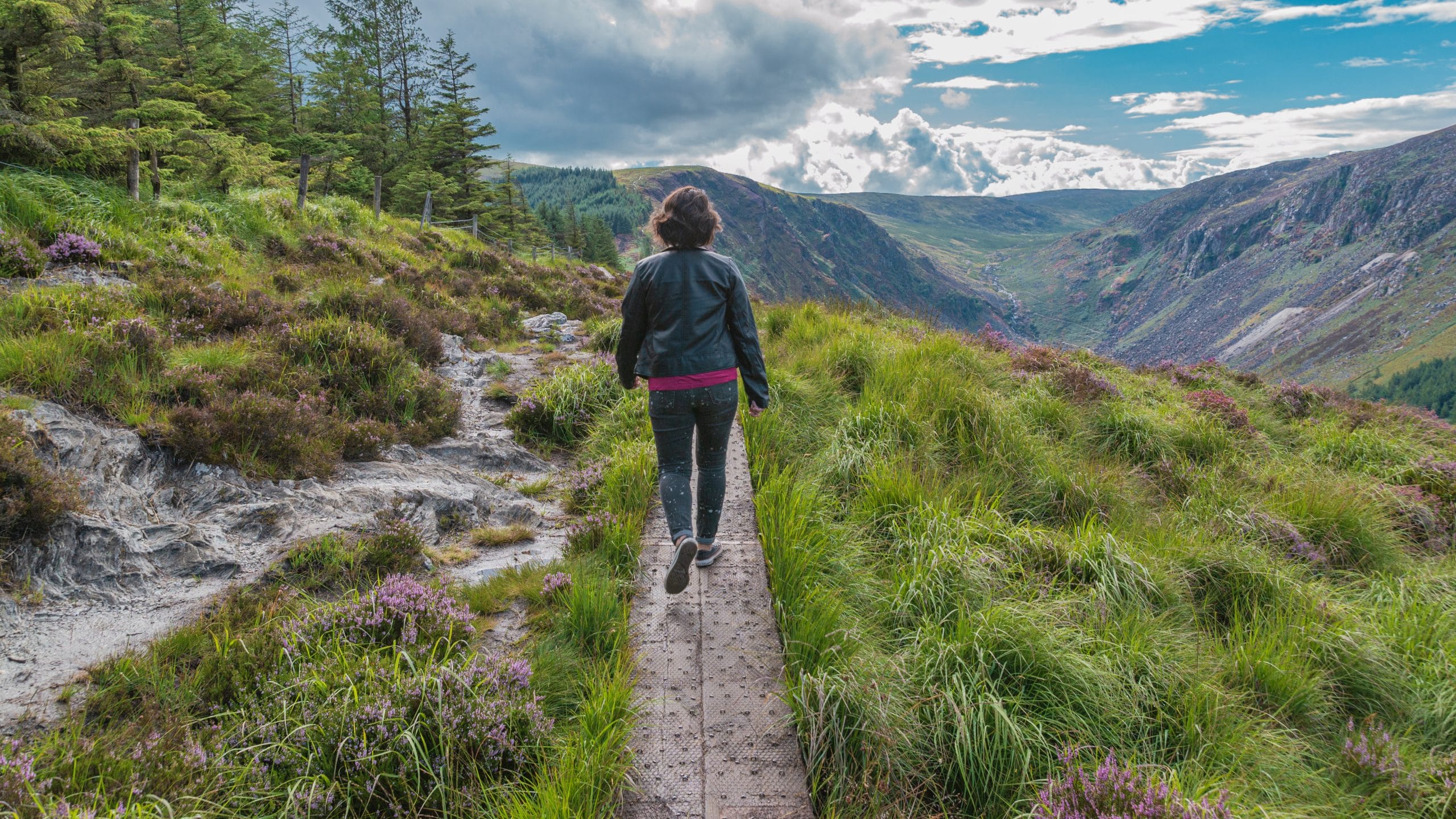
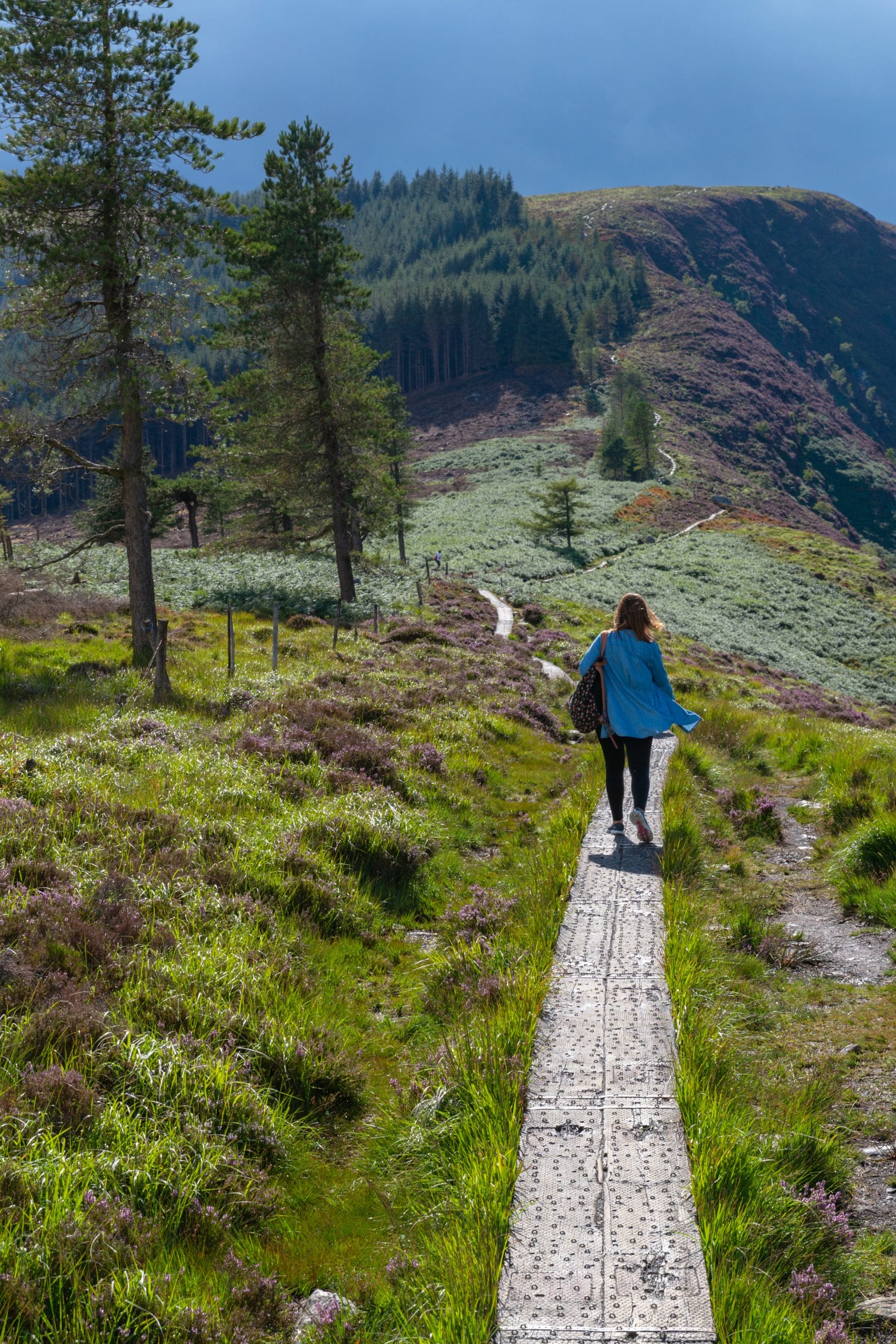


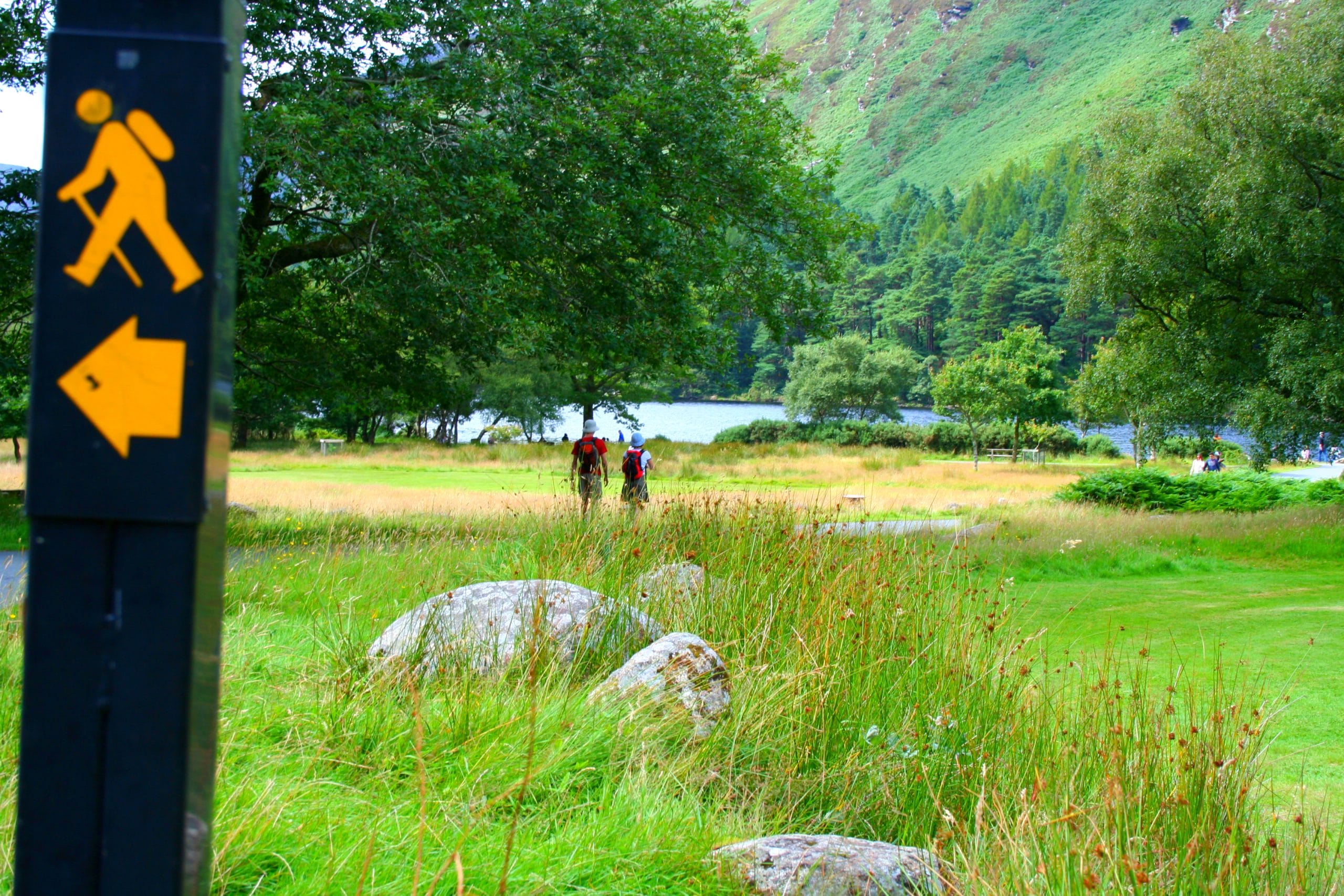

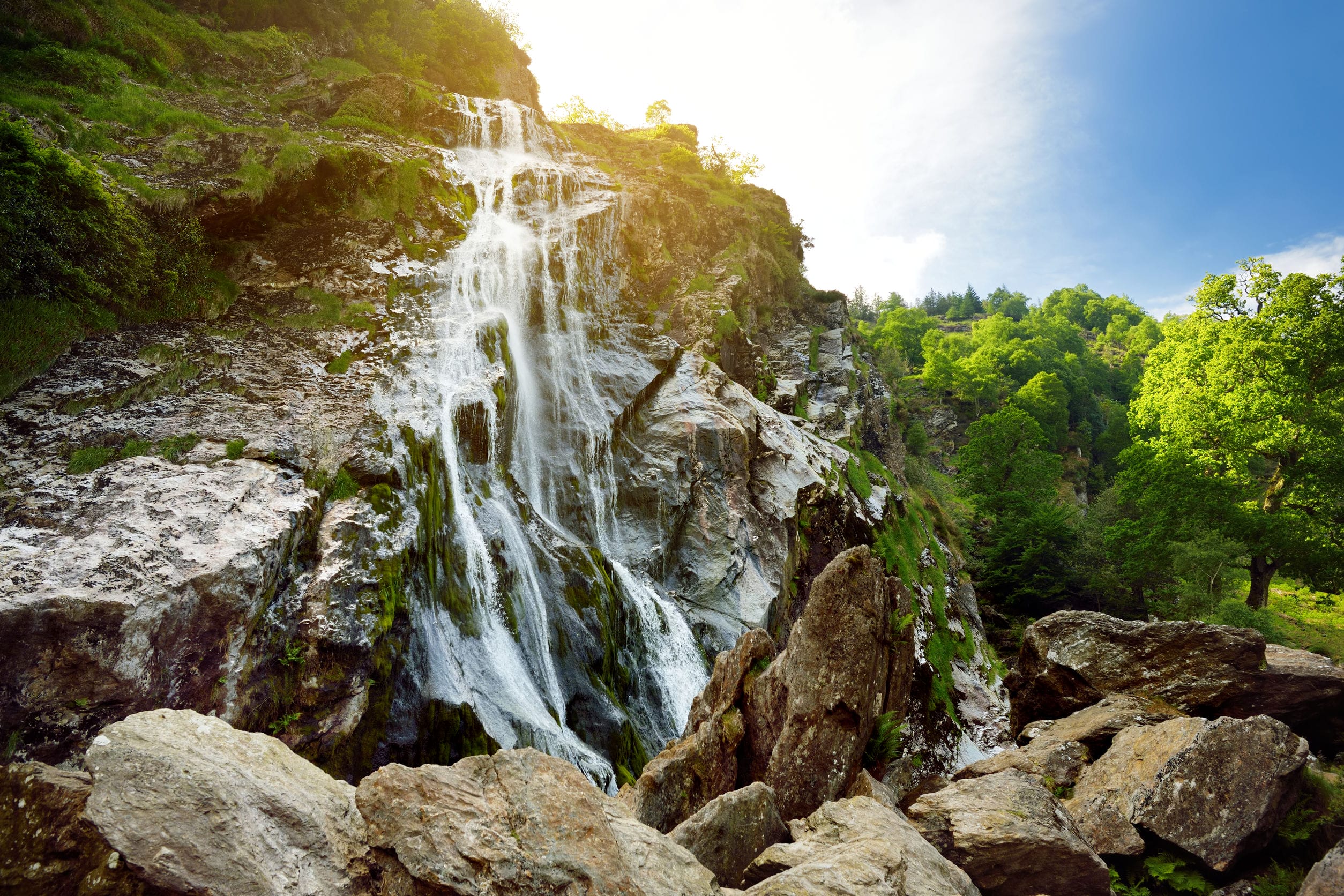
Hillwalk Tours
About Us
Hillwalk Tours is an award-winning walking tour operator which specialise in self-guided walking holidays in Ireland, Scotland, England, Wales and along the Camino de Santiago in Spain. Our goal is to create happy experiences for all of our customers, suppliers & staff.
Fill out the form below with any questions you may have and we will get back to you promptly.
Follow us on our social media platforms
Customer Reviews
Leave No Trace
We like to walk in nature and since you are reading this – we believe you do too! It is important to ensure that our impact on the environment is limited so that hikers can enjoy the same view after us. The rule applies: when you leave, make sure that nature looks the same as when you arrived or simply put “leave no trace.” As more and more people take to the great outdoors, our collective mark on the environment increases.
What does this mean in reality? Of course, do not leave any rubbish or waste behind. Do not collect stones, flowers, or other “souvenirs”. Don’t carve your name on a tree or break branches… I think you get the drift. It is imperative for walkers to play their part in making sure litter, damage to vegetation and all forms of pollution are limited.
Noise can also be a form of pollution. Whoever walks through a forest talking and laughing loudly, for example, ruins the peace and quiet of other walkers, who can no longer hear the birds. The same goes for cell phones that suddenly start ringing. Keep the volume down and respect your surroundings. Ultimately, the point is to ensure that as many people as possible can enjoy walking through nature. So that applies to you, but also to those who tread the path after you.
Hillwalk Tours proudly supports sustainable tourism and loves the countryside as it is – wild, peaceful and clean. We are proud to support the “Leave No Trace” initiative that aims to preserve the natural beauty of each nations countryside where we offer hiking holidays. We try to create happy experiences for our accommodation too, and the restaurants, shops and taxi companies that serve our walkers. These are often small businesses located in isolated areas that have been left behind by urban migration and a lack of investment in rural regions. Their warm hospitality and friendly welcomes epitomise the magic of a Hillwalk Tour and we’re dedicated to helping keep these rural communities alive.
The Benefits of Hiking
In recent years, walking and hiking outdoors has been widely reported to have numerous physical and mental health benefits. The following are examples of some of these benefits:
Improve strength and fitness
- Weight loss
- Muscle gain
- Improve metabolism
- Improve digestion
- Better quality sleep
- Increase in Vitamin D
- Improve discipline
- Sense of achievement
- Living in the present moment
Hiking Equipment List
For a more in-depth list of recommended hiking equipment list, click here.
Make A Booking
Are you ready for your Wicklow Mountains adventure? Get started by simply filling out the booking form below!


